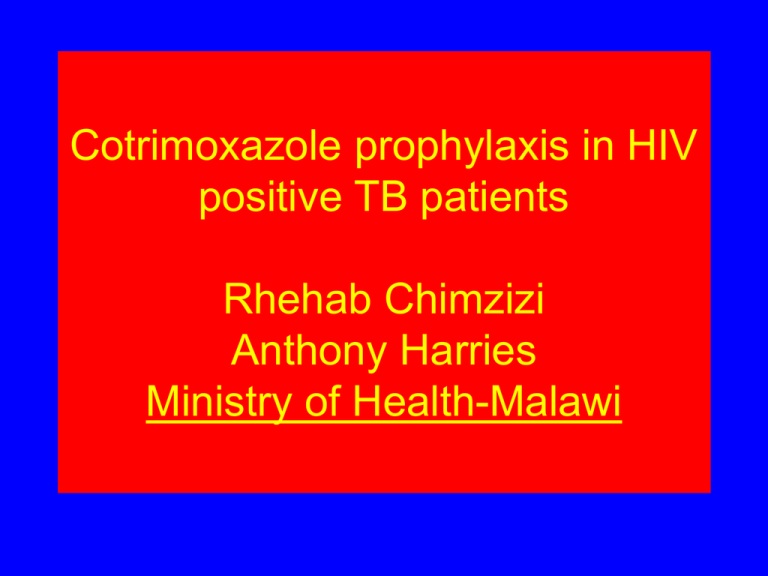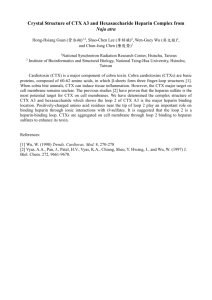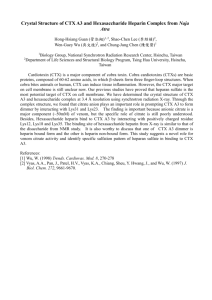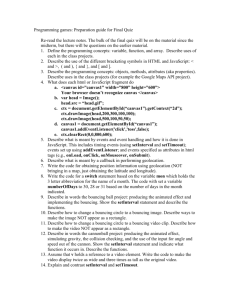Cotrimoxazole prophylaxis in HIV positive TB patients Rhehab Chimzizi Anthony Harries
advertisement

Cotrimoxazole prophylaxis in HIV positive TB patients Rhehab Chimzizi Anthony Harries Ministry of Health-Malawi What is known so far • CTX is cheap, safe antibiotic with a broad spectrum action against several HIV related and non-related pathogens • In developed countries CTX has been widely used as primary and secondary prophylaxis to prevent: – PCP – Toxoplasma gondii encephalitis CTX prophylaxis in subsaharan Africa may reduce mortality By protection against: • PCP (uncommon) • Toxoplasmic encephalitis (uncommon) • Isospora diarrhoea (common) • Bacterial infections: pneumonia, meningitis, sepsis (very common) • Malaria (very common) • CTX routine use in developing countries, particularly sub-Saharan Africa has been minimal What is the evidence base for the use of cotrimoxazole prophylaxis in HIV positive patients with TB? Early RCT’s from Cote d’Ivoire late 1990’s in HIV-1 or HIV-1,2 patients Author Pats CTX mg reduction of morbidity mortality Anglaret 1 stage 2 or 3 960 od 43% (severe events*) Wiktor 2 sm+ve TB (stage 3 or 4) 960 od 43% 46% admissions * death or hospital admission ** not designed to demonstrate mortality benefit 1 Anglaret et al, Lancet, 1999 2 Wiktor et al, Lancet, 1999 -** benefit all CD4 strata no PCP, few TE mainly bacterial infection, malaria, isosporiasis CD4<350 only (58% of pats) After Cote d’Ivoire studies WHO / UNAIDS: • stopped all placebo controlled trials (Malawi, RSA, Senegal) • provisional recommendation (2000): CTX prophylaxis (960 mg od) for HIV-infected adults and children in Africa with WHO stage 2,3 or 4 or CD4 < 500/mm3 or TLC equivalent Concerns were raised - 1 Significant reduction in events / admissions Anglaret: attributed to bacterial pneumonia malaria isosporiasis acute unexplained fever Wiktor: attributed to enteritis (isospora and NTS) septicaemia (NTS) Thus: CTX may be effective in areas where these infections are common causes of morbidity and mortality Regional differences in spectrum of HIV disease? Concerns were raised - 2 Resistance to CTX Non-Typhi Salmonellae Cote d’Ivoire (1995) Kenya (1993-94) Senegal (1996-98) Malawi (1998) : 14% : 46% : 57% : 83% Pneumococci Cote d’Ivoire (1994-96) South Africa (1999) Kenya (2000) Malawi (1998) : 3% : 10% : 54% : 91% Differences resistance patterns to CTX Concerns were raised - 3 Regarding treatment of malaria: Cotrimoxazole SP : trimethoprim-sulfamethoxazole : sulfadoxine-pyrimethamine Shared mechanisms of action: • Pyrimethamine and trimethoprim – inhibit parasite dihydrofolate reductase (DHFR) • Sulfadoxine and sulfamethoxazole – inhibit parasite dihydropteroate synthase (DHPS) Will CTX prophylaxis lead to accelerated resistance of malaria to SP? Studies from Africa in areas with high rates of resistance to CTX Senegal ( 2001) Design : RCT, CTX 480 mg vs. placebo Patients : n= 100; CD4 < 400; HIV-1 or HIV 1+2 Results: Mean follow-up: ~ 8 months Hazard ratio’s (95% CI) survival 0.84 (0.36-1.94) severe event 1.10 (0.57-2.13) clinical event 1.19 (0.55-2.59) Effect absent in all strata; CTX low dose well tolerated Maynart et al. 2001, JAIDS Studies from Africa in areas with high rates of resistance to CTX South Africa (2001) Design: Observational cohort with 5-year follow-up: Pats: HIV+ve adults in stage 2-4 or CD4 <500 CTX n =155 vs. no CTX n= 407 CTX regime: CTX 960 mg 3 x week; later 480 mg daily Badri et al. AIDS 2001 Studies from Africa in areas with high rates of resistance to CTX South Africa (2001) Outcome in those on CTX Reduced mortality in stage 3 and 4 or CD4 < 200 HR 0.56 (95% CI 0.33-0.85) Reduced incidence of HIV related illness HR 0.52 (0.38-0.68) No effect in stage 2 or CD4 200-500/mm3 CTX had a 53% improved survival rate Methodological problems Unclear starting rules Badri et al. AIDS 2001 Studies from Africa in areas with high rates of resistance to CTX South Africa (2005) Design: observational study with historical controls Pats: Intervention group (n=1321): all TB; irrespective of HIV status, CTX 960 mg Historical controls (n=2004): all TB; irrespective of HIV status, no CTX 29% reduction of mortality In a cohort of adult TB patients taking CTX irrespective of HIV status Grimwade et al. AIDS 2005 Studies from Africa in areas with high rates of resistance to CTX South Africa (2005) - ctd Adherence • 58% at 3 months; 43% at 6 months • better in females • good adherence predictive of survival deaths at 6 months: 1.8% (adherent) vs. 6% (non-adherent); p<0.001 Side-effects • 2 severe: 1 Stevens-Johnson syndrome; 1 exfoliative dermatitis • otherwise minor – no reason for stopping Grimwade et al. AIDS 2005 Studies from Africa in areas with high rates of resistance to CTX Uganda study (2004) Design: prospective cohort Pats: • HIV+ve (all stages; n=509; median age 34 years) • After 5 months follow-up HIV+ves given CTX 960 mg od; followed for another 1.5 years • HIV-ve household members (n=1522; median age 10 years) Mermin et al. Lancet 2004 Studies from Africa in areas with high rates of resistance to CTX Uganda study (2004) – ctd CTX in HIV positive persons was associated with a: • In HIV +ve before vs. after CTX Reduction in – mortality : 46% (only in CD4 < 200 or WHO 3 or 4) – malaria rate : 72% (all ages and all CD4 counts) – diarrhoea rate : 35% (age > 5 yrs, CD4 > 200 – hosp. admission :15-30% (all patients) Mermin et al. Lancet 2004 Studies from Africa in areas with high rates of resistance to CTX Uganda study (2004) - ctd Other outcomes While on CTX • lower annual mean rate of decline in CD4 count (77 vs. 203 cells/mm3; p<0.0001) • lower annual mean rate of increase in viral load (0.08 vs. 0.90 log10 copies/mL; p=0.01) Studies from Africa in areas with high rates of resistance to CTX Uganda study (2004) - ctd Other outcomes • Resistance of bacterial isolates to CTX before CTX 76% after CTX 83% • Compliance excellent >75% of CTX was taken by 90% (self-report) and by 96% (pill count) • Adverse reactions: 2% Studies done in Malawi (all in HIV +ve patients with tuberculosis) Location Design CTX Mortality reduction p Karonga cases: all TB (2004) controls: historical 960 mg od sm+ve 33 to 11% sm-ve 50 to 39% EPTB 50 to 12 % 0.01 ns 0.06 Thyolo (2003) cases: all TB controls: historical 480 mg bd sm+ve 22 to 20% sm-ve 49 to 37% EPTB 40 to 33% ns <0.01 0.05 Blantyre (2005) RCT (sm+ve only) 480 or 960 mg od 480 960 ns cases (480/960 combined) controls (NTP) 15.4% 14.0% 14.7% 21% p<0.001 Studies after CTX implementation Malawi: Thyolo (2004) Objective Evaluation of VCT+CTX package (Thyolo) and no package (Mulanje) Design: cohort study using routine NTP data Results Thyolo: Uptake VCT 97%; 69% started CTX TB treatment success Deaths Chimzizi et al. IJTLD 2004 Thyolo 75% 21% Mulanje 61% 25% p<0.001 p< 0.026 Compliance Malawi:Thyolo Pats: n=87 with HIV/TB who started CTX • Trimethoprim levels in urine as gold standard • Detected in 94% • Verbal verification and pill counts sens spec ppv Verbal verification 100 40 96.5 Pill count 91.5 60 97.4 Both 100 60 97.6 Zachariah, IJTBLD 2001 Compliance Uganda study 2004* • Compliance excellent: – took at least 75%: 90% by self-report; 96% by pill count Blantyre study** • N=579 • Compliant/over compliant 520 • Low compliance (0.6-0.8) 45 • Very low compliance (< 0.6) 14 * Mermin, Lancet 2004 ** Boeree et al, TMIH, in press Feasibility Malawi, 15 hospitals (2003) Objective: to study implementation of VCT and CTX for TB pats Time: June –Sept 2003 Place: 15 hospitals visited Results: • VCT accepted by 59% • HIV positive 68% • of those HIV+ve: 97% started CTX Chimzizi et al. IJTLD 2004 High dose vs. low dose CTX In Caucasians, for PCP prophylaxis Schneider et al. NEJM 1992: • 480 mg had equal efficacy; delayed onset of adverse reactions Ioannidis et al. Arch Intern Med 1996 • meta-analysis: CTX 480 mg: 43% decrease in severe sideeffects prompting discontinuation of CTX In Africans • Boeree et al. TMIH (in press): 480 vs. 960 mg: no differences in mortality or side-effects (but not powered to detect) High dose vs. low dose CTX Cost At IDA for a container of: 1000 caps 480 mg: Euro 4.30 (0.004 ct. per tab) 500 caps 960 mg: Euro 4.95 (0.01 ct. per tab) In uganda the cost of treating one person with CTX annaully was USD6 Conclusions -1 • Accumulating evidence that CTX is beneficial in stage 2, 3 or 4 or if CD4 <200 – reduction of morbidity and mortality – slows HIV disease progression • Also in areas with high CTX resistance • CTX resistance in the lab may not exclude efficacy of CTX as a prophylactic agent What do we need to know? Efficacy and cost-effectiveness of CTX • Stage 1, (2): no evidence of benefit but several studies lacked power • Stage 1 and 2: benefit of CTX while not on HAART yet? • How long will CTX be effective (increasing resistance)? • How long if on ART? Until CD4 >200 x 3 months? • Effect on efficacy of SP for malaria? • Safety and efficacy of CTX in HIV positive pregnant women • What is most appropriate dose? • Best delivery sites for CTX (TB, VCT, ART, PMTCT clinics What has to be done to fill the knowledge gap • Given the established benefits of CTX, further randomized controlled trials on efficiency and costeffectiveness will be difficult with CTX given as single intervention • However, in conjunction with ARV therapy a randomized controlled with or without CTX will probably be the only to way answer the question about added efficacy





